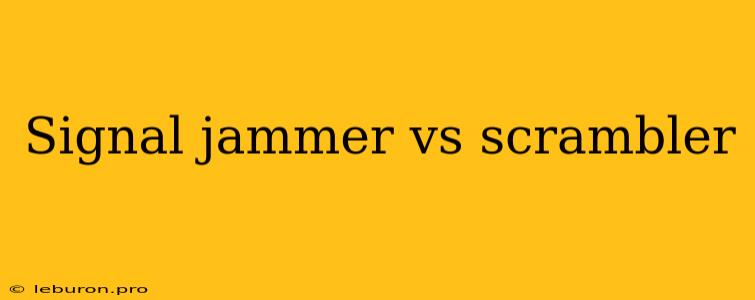The world of electronic communication is constantly evolving, leading to the development of various tools and technologies to enhance or disrupt these communications. Two such devices that often spark confusion are signal jammers and signal scramblers. While both are designed to interfere with communication signals, they operate on entirely different principles and have distinct applications. This article will delve into the intricacies of signal jammers and scramblers, exploring their functionalities, differences, and respective uses.
Understanding Signal Jammers
A signal jammer is an electronic device designed to intentionally disrupt or block wireless communication signals within a specific area. By transmitting a powerful signal at the same frequency as the targeted communication, it overwhelms the receiver, making it impossible to receive the intended signal.
Here's how a signal jammer works:
- Broadcasting Interference: The jammer broadcasts a strong signal at the same frequency as the target device (e.g., a cell phone, Wi-Fi network, or GPS system).
- Signal Overpowering: The jammer's signal overpowers the incoming signal, creating a noise floor that effectively drowns out the original communication.
- Communication Disruption: The receiver, unable to decipher the desired signal due to the interference, is rendered unable to receive information.
Types of Signal Jammers
Signal jammers come in various types, each targeting specific frequencies:
- Cell Phone Jammers: Designed to block cellular communication signals, disrupting calls and data transmissions.
- Wi-Fi Jammers: Used to disable Wi-Fi networks, preventing devices from connecting to the internet.
- GPS Jammers: Intended to disrupt GPS signals, making it difficult for devices to determine their location.
- Bluetooth Jammers: Block Bluetooth connections, rendering devices unable to communicate with Bluetooth-enabled accessories.
Legal Considerations
Signal jammers are often illegal to use in most countries. This is because their use can disrupt critical communication systems, including emergency services and public safety. Possessing or using a signal jammer without proper authorization can result in hefty fines and even jail time.
Exploring Signal Scramblers
Unlike jammers, a signal scrambler doesn't block communication signals; instead, it alters or scrambles the data being transmitted, making it unintelligible to unauthorized receivers.
Here's how a signal scrambler works:
- Data Encryption: The scrambler encrypts the data being transmitted, converting it into a seemingly random string of characters.
- Unintelligible Data: Without the correct decryption key, the scrambled data appears as gibberish to unintended recipients.
- Secure Communication: Only receivers with the decryption key can unscramble the data and access the intended information.
Types of Signal Scramblers
Signal scramblers are commonly found in various applications:
- VoIP Scramblers: Secure voice communication over the internet by scrambling voice data, preventing eavesdropping.
- Data Scramblers: Scramble data transmitted over networks, protecting sensitive information from unauthorized access.
- Military Communication Scramblers: Used by military forces to ensure secure communication between units in combat situations.
Advantages of Signal Scramblers
- Secure Communication: Signal scramblers provide a layer of security, making it much harder for unauthorized parties to intercept and understand sensitive information.
- Targeted Encryption: They specifically target the data being transmitted, unlike jammers that disrupt all communication in a given area.
- Legal Usage: Signal scramblers are generally legal for use in many applications, provided they are used for lawful purposes.
Signal Jammer vs. Scrambler: Key Differences
To avoid confusion, here's a comparison highlighting the fundamental differences between signal jammers and scramblers:
| Feature | Signal Jammer | Signal Scrambler |
|---|---|---|
| Function: | Blocks communication signals | Encrypts data to make it unintelligible |
| Mechanism: | Transmits interfering signals to drown out target signals | Alters data using encryption algorithms |
| Communication Impact: | Completely disables communication | Allows communication but makes it secure |
| Legality: | Typically illegal in most countries | Generally legal if used for legitimate purposes |
| Application: | Disrupting unwanted communication, security measures (limited) | Securing communication, protecting sensitive information |
Conclusion
Signal jammers and scramblers, despite both being designed to interfere with communication signals, are distinct technologies with unique applications. Jammers disrupt communication by flooding the receiver with interference, often resulting in illegal activities. On the other hand, scramblers encrypt data, ensuring secure communication and protecting sensitive information, making them valuable tools for legitimate purposes. Understanding the differences between signal jammers and scramblers is crucial for responsible use of electronic communication technologies and ensuring a secure communication environment.
